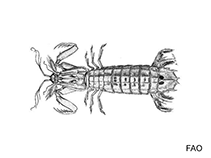Squilla cadenati Manning, 1970
Angolan mantis shrimpWarning: DOMDocument::load(): SSL operation failed with code 1. OpenSSL Error messages: error:140770FC:SSL routines:SSL23_GET_SERVER_HELLO:unknown protocol in C:\Apache24\htdocs\includes\SpeciesSummary.lib.php on line 1236
Warning: DOMDocument::load(): Failed to enable crypto in C:\Apache24\htdocs\includes\SpeciesSummary.lib.php on line 1236
Warning: DOMDocument::load(https://sealifebase.nrm.se/webservice/AquaMaps/getAMap.php?genus=Squilla&species=cadenati): failed to open stream: operation failed in C:\Apache24\htdocs\includes\SpeciesSummary.lib.php on line 1236
Warning: DOMDocument::load(): I/O warning : failed to load external entity "https://sealifebase.nrm.se/webservice/AquaMaps/getAMap.php?genus=Squilla&species=cadenati" in C:\Apache24\htdocs\includes\SpeciesSummary.lib.php on line 1236
Envoyez vos Photos
Images Google | No image available for this species;
drawing shows typical species in Squillidae.
Images Google | No image available for this species;
drawing shows typical species in Squillidae.
Classification / Names Common names | Synonyms | CoL | ITIS | WoRMS
| Stomatopoda | Squillidae
Environment: milieu / climate zone / depth range / distribution range Écologie
; profondeur 37 - 300 m (Ref. 436). Tropical
Distribution Pays | Zones FAO | Écosystèmes | Occurrences | Introductions
Eastern Atlantic: Off West Africa, from Senegal to Angola.
Length at first maturity / Taille / Poids / Âge
Maturity: Lm ? range ? - ? cm Max length : 17.0 cm BL mâle / non sexé; (Ref. 417); common length : 15.0 cm BL mâle / non sexé; (Ref. 436)
Description synthétique Morphologie
A moderately sized stomatopod. Body with conspicuous longitudinal ridges: sub median ridges of fifth abdominal segment with posterior spines; tail segment with a distinct median ridge. Claws large, armed with 6 spines on the terminal segment. Color: telson with a pair of dark triangle anteriorly, bright red in life (Ref. 436).
Found at depths of 37 to 300 m (Ref. 436).
Life cycle and mating behavior Maturité | Reproduction | Frai | Œufs | Fécondité | Larves
Some members of the order Stomatopoda pair for life and some come together only to mate. Males produce sperm ducts rather than spermatophores; females can brood a maximum of 50,000 eggs. Life cycle: Eggs hatch to a planktonic zoea which lasts for 3 months.
Référence principale
Références | Coordinateur | Collaborateurs
Schneider, W. 1990. (Ref. 417)
Statut dans la liste rouge de l'IUCN (Ref. 130435)
statut CITES (Ref. 108899)
Not Evaluated
CMS (Ref. 116361)
Not Evaluated
Menace pour l'homme
Harmless
Utilisations par l'homme
| FishSource |
Outils
Plus d'informations
Pays
Zones FAO
Écosystèmes
Occurrences
Introductions
Stocks
Écologie
Régime alimentaire
Éléments du régime alimentaire
Zones FAO
Écosystèmes
Occurrences
Introductions
Stocks
Écologie
Régime alimentaire
Éléments du régime alimentaire
Sources Internet
BHL | BOLD Systems | CISTI | DiscoverLife | FAO(Publication : search) | Fishipedia | GenBank (genome, nucleotide) | GloBI | Gomexsi | Google Books | Google Scholar | Google | PubMed | Arbre de Vie | Wikipedia (Go, chercher) | Zoological Record
Estimates based on models
Preferred temperature
(Ref. 115969): 14.2 - 17.8, mean 16.3 (based on 35 cells).
Catégorie de prix
(Ref. 80766):
Unknown.



